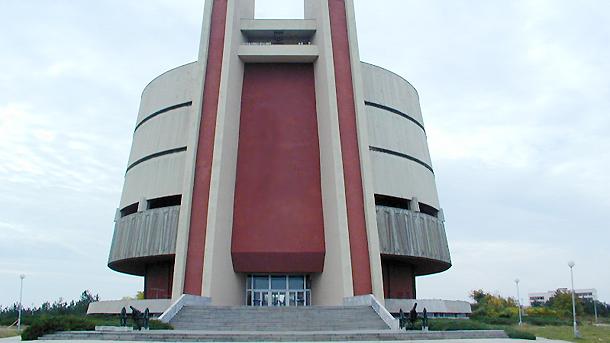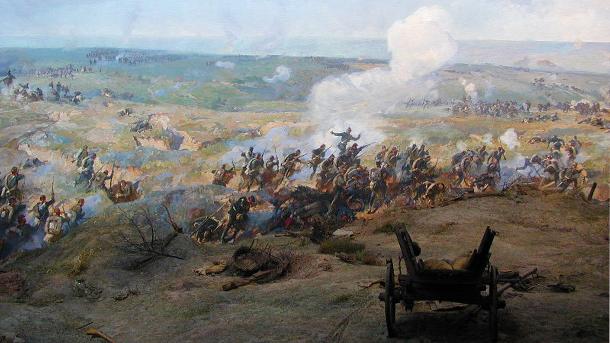Panorama art is a relatively young genre, even though it first appeared some 200 years ago. Nowadays it is a combination of special light effects and original historical objects which gradually flow into a large scale wall painting depicting historic scenes, in most cases in a chronological order. This makes the spectator get emotionally involved in the historic material presenting various events. There exist worldwide 33 panoramas of this type. The Bulgarian one stands in the heart of the wide Danubean plane, in Northern Bulgaria, near the town of Pleven and is said to be one of the largest expositions in the world.

The historic accent of Pleven Panorama is the episode in the Russo-Turkish war of 1877-78. For the Bulgarians it was a war of liberation from the 500 years long Turkish rule over the Bulgarian lands. In the vicinity of the town of Pleven the Russian army went into heavy battles for 5 months on end before being able to defeat the Turkish forces and liberate the city of Pleven. Pleven Panorama, however, is not only a historical monument. It is a panegyric to the heroic deed of Russian and Rumanian soldiers who fought together for Bulgaria’s freedom and a tribute to those who perished in the Pleven battlefields in the autumn of 1877. The Panorama was built on the occasion of the 100th anniversary since the liberation of the town. It stands on the battle field itself.
“When the visitor finds himself in the centre of the event in the panorama hall he feels the tension in these events”, says Grozdanka Asparuhova, a guide at the museum. “The moment of the battle depicted on the panoramic wall shows Russian General Skobelev who has thrown in the attack all his reserves. At that time starts the counter attack of the Turks coming. This is a critical moment because at that point Skobelev has nothing else to rely upon. At that moment he appeared in all his glamour, with his all white uniform which won him the name of “The White General” and lead his troops, sward in hand. The General’s appearance brought about such enthusiasm, that that the battle ended in a victory for his army.”
The lobby of the big hall is covered by large scale canvasses depicting important historical scenes preceding the Russo-Turkish war of 1877-78. One of them is the April Uprising of 1876. Another canvass shows a large street meeting in Saint Petersburg, Russia, in defense of the Bulgarians after the tragic massacres having drowned in blood the uprising. Yet another canvass shows how the liberation army crosses the Danube from the North and the battle for the Samara Banner under which gathered to fight for the freedom of their fatherland thousands of Bulgarian volunteers from abroad. As an epilogue of the Panorama one can see the huge canvass depicting the last battle for the liberation of the town of Pleven, Northern Bulgaria, on December 10, 1877. This great battle defeated the army of Turkish army leader Osman Pasha in the valley of the Vit river near Pleven.
“Visitors can see here other interesting things as well,” Mrs. Asparuhova continues. “We have on display artillery devices and guns from those days, pictures and etchings, some of which have been made the very year of the liberation war, as well as icons from the field chapel of Russian Emperor Alexander II. Original guns and swards from the battles near Pleven as well as Russian officer uniforms and Rumanian weapons can also be seen.”
The outer appearance of the Pleven Panorama is a symbolic one. It represents 3 rings, standing for the 3 major attacks for breaking the siege of the town. It also stands for the 3 nationalities having taken part in the liberation battles – Bulgarians, Russians and Rumanians. The building stands upon four concrete bayonets symbolizing the victory of the Russian liberation army and the Bulgarian volunteer troops. Spreading all around it is the park, which has been named after General Skobelev.

Here is Mrs. Asparuhova again, with more information on the park, this time: “This park is built on the places where the battles took place during the third attack for taking over the town of Pleven. All the heavy cannons scattered all over the place are the original ones. In the centre of the park there is an ossuary keeping the bones of General Skobelev’s soldiers killed in the battles. Two Turkish fortifications have been restored – one just behind the ossuary and the other facing the exit of the Panorama building. These were exactly the two Turkish fortifications which were taken over by the White General’s troops and brought the victorious outcome of the battle.” 
"The third Attack"
It is interesting to know that during the three attacks at Pleven the number of dead was 6 500. Since those days the valley where the Skobelev park stands is called the Dead Valley. That is how people call it to this day.
In terms of bird diversity Bulgaria occupies one of the leading places in Europe and is among the the TOP 5 destinations for birdwatching tourism on the Old Continent, we learn from our conversation with Dr. Georgi Gerdzhikov, who has..
The Ministry of Tourism presented Bulgaria at the International Golf Travel Market (IGTM), held from October 14 to 17, 2024, in Lisbon. This is the largest event in the golf tourism industry, held annually in different destinations since 1998...
The awards in the "Hut of the Year" competition, a joint initiative of 360Mag magazine and the Bulgarian Tourist Union, were presented at a ceremony in the Cinema House in Sofia. More than 100 mountain lodges and shelters from all..
The ski runs in the three major winter resorts of Bulgaria - Borovets, Bansko and Pamporovo, are well covered with snow before the official start of the..

+359 2 9336 661
